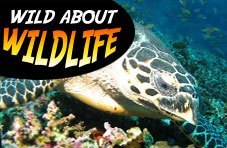South Africa boasts a rich marine biodiversity along its 3,000 km coastline. The tropical Indian Ocean and the cold Atlantic Ocean feature an impressive variety of marine life, ranging from single cell algae, sea-horses, nudibranchs and Christmas-tree worms, to large mammals and predators. After moving inland, you’ll once again be amazed by water-loving creatures spending their lives in the rivers and lakes of this beautiful country.
The Marine Big Five
When talking about South Africa and the Big Five, everybody will immediately think of the leopard, lion, elephant, rhino and buffalo. But the oceans are home to another set of five, amazing wild animals – the Great White Shark, Southern Right Wales, dolphins, Cape Fur Seal, and the African Penguin. The latter can be spotted in colonies around the Western Cape, waddling around always dressed for the occasion. Cape Fur Seals are playful aquatic mammals which are not afraid to approach humans, and if you go for a scuba dive, you might even see one swimming alongside you. Dolphins are surfing both the Indian and Atlantic oceans, jumping in and out of the sea, and in a similar manner as that of skillful sheep dogs, herding sardines and pushing them to the surface where they have themselves a feast. You might feel intimidated by the Southern Right Whale due to its size (as long as 16 meters and weighing as much as 60 tons), but this gentle giant is a skilled acrobat which puts on an impressive show while engaging in the characteristics of blowing, breaching and lob-tailing.
Other Ocean Inhabitants
The east coast of South Africa is one the last breeding grounds for several sea turtle species which visit Maputaland beaches every year to lay eggs. The giant Leatherback is the biggest among them, weighing as much as 360 kilograms, and quite unique. Instead of sporting a shell, it carries a protective covering made of hundreds of bony plates covered by a leathery skin.
Nudibranchs, or sea slugs, range from 4mm to 60 cm in size and come in striking forms and amazing colors. They lose their shells after larval stage, have tentacles sensitive to touch, taste and smell, and also possess some venomous appendages which protect them from predators. Christmas tree worms have tubular, segmented bodies enclosed in a calcareous tube, and multicoloured spirals used for feeding and respiration. These spiral structures shaped like Christmas trees are what got them their name. You’ll normally find these beautiful-looking creatures embedded in heads of massive corals.
Dugong is a marine mammal of the Sirenia family, shaped like a spindle, with paddle-like front flippers, a dolphin-like tail, and a muzzle with a horseshoe-shaped upper lip. Having been hunted for a long time for their meat and oil, the dugong population is continuously shrinking and the species are now listed as vulnerable to extinction.
South African Rivers Full of Life
There is one river-dweller which is just as typical of Africa as the above listed Top Five – the crocodile. The Nile crocodile is second largest reptile in the world, found throughout Sub-Saharan Africa in rivers, lakes and marshlands. The male adult can grow to impressive 5 meters in length and weigh as much as 750 kg. These highly aggressive animals feed on fish, reptiles, birds and mammals, and are quite capable of lying in ambush for ages before striking. Don’t let the crocodile’s green eyes enchant you and bring you too close, or you might have a first-hand experience of their powerful bite which is almost impossible to loosen.
Hippos are semi–aquatic animals found in the St Lucia Estuary, Kruger National Park and other protected areas, but occasionally also in major rivers and swamps. They need open water in which they can submerge (thin skin makes them sensitive to heat), sandbanks to lie in the sun (especially during winter months), and a good supply of grazing grass close by. You’ll know when you're approaching a hippo by hearing extremely loud grunts, bellows, snorts and cries.
The biggest variety of South African amphibians is found in the eastern part of the country (KwaZulu-Natal). A Spotted Snout-Burrower is a frog which inhabits grassland and savanna. It breeds in swampy areas and pools which have formed near rivers. It is usually dark purple or brown in color, with numerous yellow dots. It also has a globular body, small pointed head and tiny eyes. The frog uses it's Pointed snout to burrow head-first, and this is how the frog got its name. After mating, the female will lay about 200 eggs in the burrow, and when they are ready to hatch, mum will dig a tunnel towards the water where tadpoles will further develop.
Table Mountain hosts the ever so rare and elusive Table Mountain Ghost Frog and is endemic to South Africa, Lesotho and Swaziland. The frog is well-adapted for a life in fast-flowing mountain streams. Adults use pads on their webbed toes to cling onto slippery, wet surfaces, and tadpoles do the same with the help of their sucker-like mouths. Meanwhile, their streamlined bodies allow for the water to flow over them with little resistance. The species is, unfortunately, another one listed as critically endangered.




